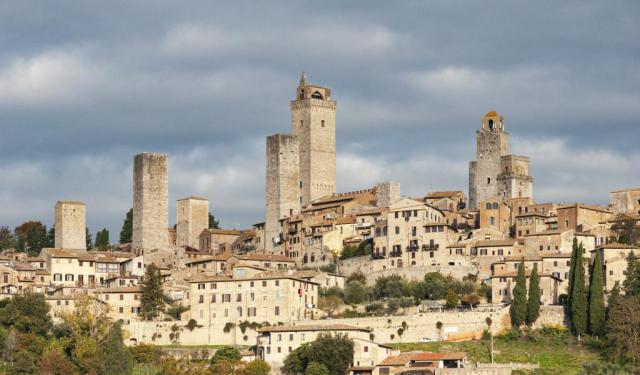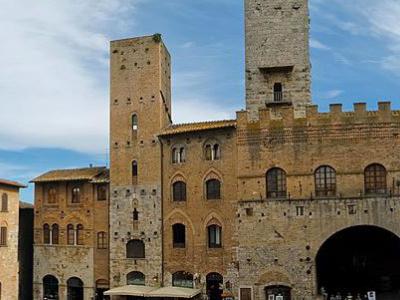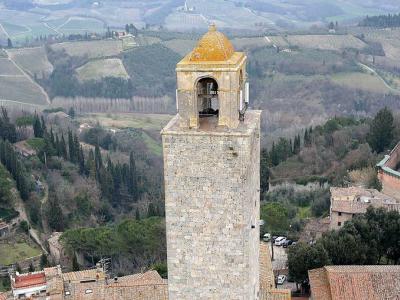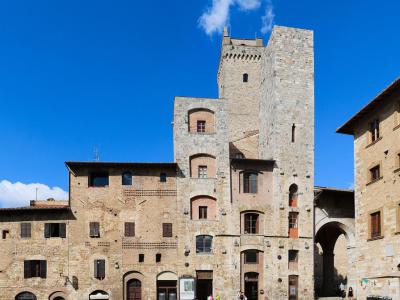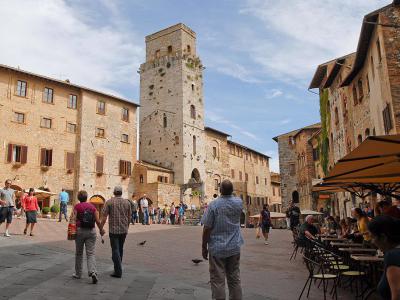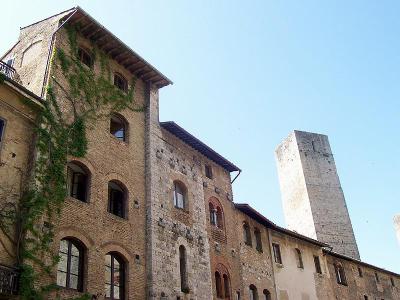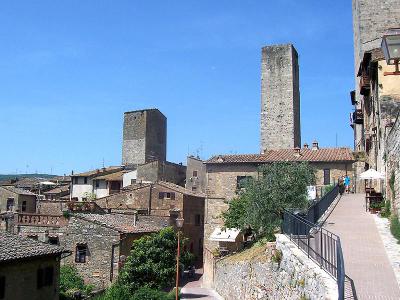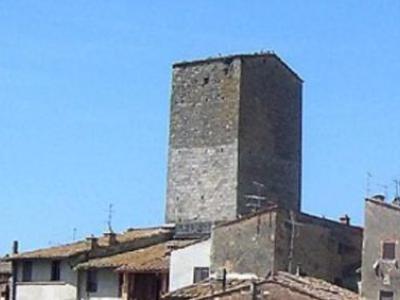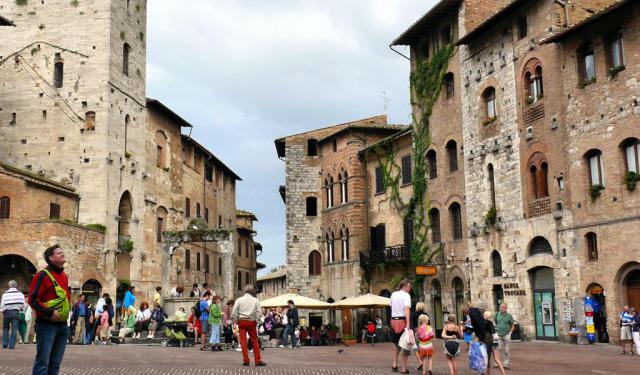San Gimignano Towers Walk (Self Guided), San Gimignano
Known as the “Manhattan of the Middle Ages”, San Gimignano is renowned for its collection of medieval skyscrapers whose verticality and density produce a rather unique and impressive sight.
Clustered together, these slender towers served as both family homes and status symbols for the noble families who built them. Apart from showcasing the prosperity and influence of their owners, they also symbolized their ability to defend themselves in times of trouble.
The taller the tower, the more important the owner appeared to be. The competition would lead to conflicts and often families would feud for decades and split the loyalties of the citizens. Legends tell stories of young lovers from quarreling families who would meet in secret, in the shadows of the towers, like real-life Romeos and Juliets.
At the height of San Gimignano's tower-building era, during the 12th and 13th centuries, there were about 70 towers in the town gracing its skyline. They varied in height, with the tallest ones reaching up to 70 meters (230 feet). The towers were predominantly constructed using local stone, known as "pietra serena," and featured sturdy walls and narrow windows.
Today, only 14 towers remain in place. The most famous of them is the Big Tower (Torre Grossa), which stands at the highest point of the town and offers panoramic views of the surrounding countryside. The Devil's Tower (Torre del Diavolo) and the twin towers of the Ardinghelli family, as well as the Torri dei Cugnanesi, are among the other notable surviving towers.
Recognized as a UNESCO World Heritage site in 1990, these "Guardians of San Gimignano" reach for the heavens creating a canvas of medieval enchantment. It seems like the brushstrokes of time have painted San Gimignano as a masterpiece of architectural marvels, whose spell, when cast upon the beholder, can transport him to another era.
Complete with its iconic towers, San Gimignano is a treasure trove of medieval magnificence. To appreciate fully the architectural prowess of the town, take this self-guided walk.
Clustered together, these slender towers served as both family homes and status symbols for the noble families who built them. Apart from showcasing the prosperity and influence of their owners, they also symbolized their ability to defend themselves in times of trouble.
The taller the tower, the more important the owner appeared to be. The competition would lead to conflicts and often families would feud for decades and split the loyalties of the citizens. Legends tell stories of young lovers from quarreling families who would meet in secret, in the shadows of the towers, like real-life Romeos and Juliets.
At the height of San Gimignano's tower-building era, during the 12th and 13th centuries, there were about 70 towers in the town gracing its skyline. They varied in height, with the tallest ones reaching up to 70 meters (230 feet). The towers were predominantly constructed using local stone, known as "pietra serena," and featured sturdy walls and narrow windows.
Today, only 14 towers remain in place. The most famous of them is the Big Tower (Torre Grossa), which stands at the highest point of the town and offers panoramic views of the surrounding countryside. The Devil's Tower (Torre del Diavolo) and the twin towers of the Ardinghelli family, as well as the Torri dei Cugnanesi, are among the other notable surviving towers.
Recognized as a UNESCO World Heritage site in 1990, these "Guardians of San Gimignano" reach for the heavens creating a canvas of medieval enchantment. It seems like the brushstrokes of time have painted San Gimignano as a masterpiece of architectural marvels, whose spell, when cast upon the beholder, can transport him to another era.
Complete with its iconic towers, San Gimignano is a treasure trove of medieval magnificence. To appreciate fully the architectural prowess of the town, take this self-guided walk.
How it works: Download the app "GPSmyCity: Walks in 1K+ Cities" from Apple App Store or Google Play Store to your mobile phone or tablet. The app turns your mobile device into a personal tour guide and its built-in GPS navigation functions guide you from one tour stop to next. The app works offline, so no data plan is needed when traveling abroad.
San Gimignano Towers Walk Map
Guide Name: San Gimignano Towers Walk
Guide Location: Italy » San Gimignano (See other walking tours in San Gimignano)
Guide Type: Self-guided Walking Tour (Sightseeing)
# of Attractions: 8
Tour Duration: 1 Hour(s)
Travel Distance: 0.2 Km or 0.1 Miles
Author: DanaOffice
Sight(s) Featured in This Guide:
Guide Location: Italy » San Gimignano (See other walking tours in San Gimignano)
Guide Type: Self-guided Walking Tour (Sightseeing)
# of Attractions: 8
Tour Duration: 1 Hour(s)
Travel Distance: 0.2 Km or 0.1 Miles
Author: DanaOffice
Sight(s) Featured in This Guide:
- Torre Grossa (Big Tower)
- Torre Chigi (Chigi Tower)
- Torre Rognosa (Rognosa Tower)
- Torri degli Ardinghelli (Ardinghelli Towers)
- Torre dei Diavolo (Devil's Tower)
- Torre dei Becci (Becci Tower)
- Torre dei Cugnanesi (Cugnanesi Tower)
- Torre e Casa Campatelli (Campatelli Tower and House)
1) Torre Grossa (Big Tower) (must see)
And the prize for the tallest tower goes to...Big Tower (Torre Grossa)! Built in 1311 and measuring 177 feet in height, it is one of Tuscany's most famous medieval towers. It is the only one of two of the existing 14 towers of the town that is open to the public. The walls of the tower enclose a belfry with a walkway to the top and the best views in town.
Construction began on August 21, 1300, four months after a visit to the city by the great Italian poet Dante Alighieri. The tower is square, with walls seven feet thick made of stone bricks. The towers of the town were built originally as defensive lookout towers. Attacks from other towns and even nearby families were not unusual.
Noble families came to value the towers as status symbols. Having the biggest tower in town was a great way to show up one's neighbors. Big Tower was the envy of the city. The adjoining Town Hall (Palazzo Comunale) is also open to the public. There are 218 steps and a ten-foot ladder to the top of the tower and the best views in Tuscany.
The tower competition among the families building their tower houses resulted in taller and taller residences. By the end of the medieval period there were towers measuring as high as 230 feet above the street. Finally the council ruled no tower could be taller than that of the Town Hall, which happened to be Big Tower.
The city with its towers flourished until 1349. The Black Death had arrived in Europe. San Gimignano lost half its population. The city was submitted to the rule of Florence. The era of higher and higher tower building was over. San Gimignano kept its Medieval appearance until the age of tourism. In a strange way, the plague was a mixed blessing.
Construction began on August 21, 1300, four months after a visit to the city by the great Italian poet Dante Alighieri. The tower is square, with walls seven feet thick made of stone bricks. The towers of the town were built originally as defensive lookout towers. Attacks from other towns and even nearby families were not unusual.
Noble families came to value the towers as status symbols. Having the biggest tower in town was a great way to show up one's neighbors. Big Tower was the envy of the city. The adjoining Town Hall (Palazzo Comunale) is also open to the public. There are 218 steps and a ten-foot ladder to the top of the tower and the best views in Tuscany.
The tower competition among the families building their tower houses resulted in taller and taller residences. By the end of the medieval period there were towers measuring as high as 230 feet above the street. Finally the council ruled no tower could be taller than that of the Town Hall, which happened to be Big Tower.
The city with its towers flourished until 1349. The Black Death had arrived in Europe. San Gimignano lost half its population. The city was submitted to the rule of Florence. The era of higher and higher tower building was over. San Gimignano kept its Medieval appearance until the age of tourism. In a strange way, the plague was a mixed blessing.
2) Torre Chigi (Chigi Tower)
Situated in the heart of San Gimignano's Cathedral Square, the Chigi Tower stands proudly among the fourteen historic towers that grace the skyline of this medieval town.
Although not towering over the city, the Chigi Tower's elegance and beauty make it one of the most captivating structures in San Gimignano. Its construction dates back to 1280 when it was originally owned by the Useppi family. Today, it is under the ownership of the Giachi Cilemmi family, who have preserved its rich heritage.
The tower showcases a distinctive architectural style across its three floors. The lower three levels feature exposed stone, meticulously cut into well-squared drafts, with gracefully arched openings that invite natural light. The first floor displays a characteristic portal, accessed by stairs-a reminder of the turbulent times of internal conflicts in medieval cities. To ensure safety during the night, stairs were often retracted, allowing access only to the first floor.
Moving to the second floor, a narrow slit window with an elongated arch rests on shelves, adding a touch of architectural intrigue. The upper section of the tower is adorned with brickwork, featuring two identical single-lancet windows on the first two floors, while the top floor remains windowless. Each floor is adorned with orderly rows of four scaffolding holes, accompanied by shelves. These openings suggest the presence of wooden balconies in the past, providing additional space within the tower.
Flanked by neighboring medieval buildings, the Chigi Tower stands as a harmonious part of the architectural ensemble. Particularly noteworthy is the building on the left side, distinguished by gracefully crafted mullioned windows, adding a touch of refinement to the surroundings.
Although not towering over the city, the Chigi Tower's elegance and beauty make it one of the most captivating structures in San Gimignano. Its construction dates back to 1280 when it was originally owned by the Useppi family. Today, it is under the ownership of the Giachi Cilemmi family, who have preserved its rich heritage.
The tower showcases a distinctive architectural style across its three floors. The lower three levels feature exposed stone, meticulously cut into well-squared drafts, with gracefully arched openings that invite natural light. The first floor displays a characteristic portal, accessed by stairs-a reminder of the turbulent times of internal conflicts in medieval cities. To ensure safety during the night, stairs were often retracted, allowing access only to the first floor.
Moving to the second floor, a narrow slit window with an elongated arch rests on shelves, adding a touch of architectural intrigue. The upper section of the tower is adorned with brickwork, featuring two identical single-lancet windows on the first two floors, while the top floor remains windowless. Each floor is adorned with orderly rows of four scaffolding holes, accompanied by shelves. These openings suggest the presence of wooden balconies in the past, providing additional space within the tower.
Flanked by neighboring medieval buildings, the Chigi Tower stands as a harmonious part of the architectural ensemble. Particularly noteworthy is the building on the left side, distinguished by gracefully crafted mullioned windows, adding a touch of refinement to the surroundings.
3) Torre Rognosa (Rognosa Tower)
The Rognosa Tower, also referred to as Clock Tower, or Podestà Tower, stands as one of the tallest and remarkably well-preserved structures in San Gimignano.
Constructed around 1200, the tower originally belonged to the Gregori and Oti family. Rising to an impressive height of nearly 52 meters, it claims the distinction of being the second tallest tower in the town, just slightly shorter than the Big Tower, which reaches 54 meters.
The name "Rognosa" stems from its historical use as a prison after the podestà (chief magistrate) relocated. It became a place visited by those who had transgressed the law, earning it the association with the word "trogne," meaning grimaces or scowls.
The tower boasts an almost square base, crafted from stone with evenly spaced courses. Positioned just above the merlons of the Old Authority Palace, a narrow architraved opening grants access to a small terrace adorned with a protective canopy. Facing the Cistern Square, the tower features a solitary window, while its uppermost floor showcases a roof terrace that served as a secular belfry. This platform was utilized to summon citizens in times of danger or for various reasons unrelated to religious affairs. Eventually, it became the perch for a bell, tolling the hours. The bell cell, with its four arches supported by sturdy pillars, is crowned by a diminutive pyramid adorned with red tiles.
In accordance with a statute dating back to 1255, the construction of towers taller than the Rognosa was forbidden to private citizens. However, this provision was disregarded by the influential Guelph family of the Salvucci, who erected two matching towers in close proximity. Soon after, the rival Ardinghelli family followed suit with their own pair of towers. However, all four towers were subsequently truncated, resulting in their current lower stature compared to the Rognosa.
Constructed around 1200, the tower originally belonged to the Gregori and Oti family. Rising to an impressive height of nearly 52 meters, it claims the distinction of being the second tallest tower in the town, just slightly shorter than the Big Tower, which reaches 54 meters.
The name "Rognosa" stems from its historical use as a prison after the podestà (chief magistrate) relocated. It became a place visited by those who had transgressed the law, earning it the association with the word "trogne," meaning grimaces or scowls.
The tower boasts an almost square base, crafted from stone with evenly spaced courses. Positioned just above the merlons of the Old Authority Palace, a narrow architraved opening grants access to a small terrace adorned with a protective canopy. Facing the Cistern Square, the tower features a solitary window, while its uppermost floor showcases a roof terrace that served as a secular belfry. This platform was utilized to summon citizens in times of danger or for various reasons unrelated to religious affairs. Eventually, it became the perch for a bell, tolling the hours. The bell cell, with its four arches supported by sturdy pillars, is crowned by a diminutive pyramid adorned with red tiles.
In accordance with a statute dating back to 1255, the construction of towers taller than the Rognosa was forbidden to private citizens. However, this provision was disregarded by the influential Guelph family of the Salvucci, who erected two matching towers in close proximity. Soon after, the rival Ardinghelli family followed suit with their own pair of towers. However, all four towers were subsequently truncated, resulting in their current lower stature compared to the Rognosa.
4) Torri degli Ardinghelli (Ardinghelli Towers)
The Ardinghelli Towers form a prominent part of the fourteen medieval towers that grace San Gimignano. These towers are situated in the Cistern Square, at the corner where it meets the Cathedral Square.
The Ardinghelli family, the leading Ghibelline faction in San Gimignano, were fierce rivals of the Guelph Salvucci family. They amassed wealth through trade and finance, cultivating commercial connections with Lombardy and the East.
Dating back to the flourishing era of construction in San Gimignano, particularly the 13th century, the two Ardinghelli Towers emerged as notable structures. In defiance of the explicit prohibition imposed in 1255, these towers surpassed the height of the Rognosa Tower, the town hall tower that measured around 52 meters. The Ardinghelli Towers were constructed in response to the similarly "outlawed" twin towers of the nearby Salvucci family.
The tower adjacent to the loggia, which stands almost fifty meters tall, remained intact until 1870 when it was reduced by nearly two-thirds due to stability concerns. In the 1930s, it was raised by a few meters. Originally, the two towers were connected by an arch, and the bases of this arch can still be observed above the current roof level. The other tower, characterized by large openings on its lower floors, has been partially filled in and decapitated in ancient times.
Although both towers possess a quadrilateral base, they exhibit notable differences in their architectural features. The tower on the right is narrower and boasts a more austere medieval appearance. Its facade showcases well-cut, visible stone drafts, with a few narrow single-lancet windows and a loophole.
Conversely, the left tower has a larger surface area and is adorned with substantial arched windows. These windows suggest a structural utilization of arches to alleviate the weight of the masonry. While some of these openings have been filled with brick, their original form remains discernible. Regularly spaced scaffolding holes adorn the tower's height, and the ground floor features a portal with an architrave.
The Ardinghelli family, the leading Ghibelline faction in San Gimignano, were fierce rivals of the Guelph Salvucci family. They amassed wealth through trade and finance, cultivating commercial connections with Lombardy and the East.
Dating back to the flourishing era of construction in San Gimignano, particularly the 13th century, the two Ardinghelli Towers emerged as notable structures. In defiance of the explicit prohibition imposed in 1255, these towers surpassed the height of the Rognosa Tower, the town hall tower that measured around 52 meters. The Ardinghelli Towers were constructed in response to the similarly "outlawed" twin towers of the nearby Salvucci family.
The tower adjacent to the loggia, which stands almost fifty meters tall, remained intact until 1870 when it was reduced by nearly two-thirds due to stability concerns. In the 1930s, it was raised by a few meters. Originally, the two towers were connected by an arch, and the bases of this arch can still be observed above the current roof level. The other tower, characterized by large openings on its lower floors, has been partially filled in and decapitated in ancient times.
Although both towers possess a quadrilateral base, they exhibit notable differences in their architectural features. The tower on the right is narrower and boasts a more austere medieval appearance. Its facade showcases well-cut, visible stone drafts, with a few narrow single-lancet windows and a loophole.
Conversely, the left tower has a larger surface area and is adorned with substantial arched windows. These windows suggest a structural utilization of arches to alleviate the weight of the masonry. While some of these openings have been filled with brick, their original form remains discernible. Regularly spaced scaffolding holes adorn the tower's height, and the ground floor features a portal with an architrave.
5) Torre dei Diavolo (Devil's Tower)
The Devil's Tower stands as one of the surviving fourteen medieval towers of San Gimignano, out of the numerous towers that once dotted the town during the Middle Ages. It is located on the northern side of Cistern Square and was originally part of the adjacent Cortesi Palace.
Legend has it that the tower earned its name due to the astonishing height that the owner discovered upon returning from a trip. The extraordinary elevation was believed to be the work of the devil himself, leaving the owner in awe and amazement.
This imposing tower features a double-height portal, hinting at its former use as a pedestrian passage. Indeed, at the base of the tower lay the "Alley of Gold," a narrow alley where goldbeaters had their shops. These skilled artisans would pound gold into incredibly thin sheets, which were then used for gold background panels in paintings.
The upper floor of the tower is distinguished by a row of scaffolding holes adorned with shelves, indicating the presence of an ancient wooden balcony. A narrow slit window provides illumination on this level, while narrow windows, one per floor, can be found on subsequent levels. These small windows reflect the architectural style of the medieval period, prioritizing defensive needs over the comfort and lighting of interior spaces. The top floor, surrounded by prominent shelves, likely housed a platform encircling the existing brick roof terrace. The somewhat eerie appearance of the supports may have contributed to the tower's association with the legend.
The adjacent Cortesi Palace, which stands in contrast to the tower, features only two floors, each adorned with a single lancet window. Unlike the tower's white limestone construction, the palazzo is built from a slightly darker, yellowish stone.
Legend has it that the tower earned its name due to the astonishing height that the owner discovered upon returning from a trip. The extraordinary elevation was believed to be the work of the devil himself, leaving the owner in awe and amazement.
This imposing tower features a double-height portal, hinting at its former use as a pedestrian passage. Indeed, at the base of the tower lay the "Alley of Gold," a narrow alley where goldbeaters had their shops. These skilled artisans would pound gold into incredibly thin sheets, which were then used for gold background panels in paintings.
The upper floor of the tower is distinguished by a row of scaffolding holes adorned with shelves, indicating the presence of an ancient wooden balcony. A narrow slit window provides illumination on this level, while narrow windows, one per floor, can be found on subsequent levels. These small windows reflect the architectural style of the medieval period, prioritizing defensive needs over the comfort and lighting of interior spaces. The top floor, surrounded by prominent shelves, likely housed a platform encircling the existing brick roof terrace. The somewhat eerie appearance of the supports may have contributed to the tower's association with the legend.
The adjacent Cortesi Palace, which stands in contrast to the tower, features only two floors, each adorned with a single lancet window. Unlike the tower's white limestone construction, the palazzo is built from a slightly darker, yellowish stone.
6) Torre dei Becci (Becci Tower)
The Becci Tower stands proudly among the fourteen remaining towers of San Gimignano. It is strategically located near the ancient Arc ofBecci and commands views over both Via San Giovanni and Cistern Square.
Dating back to the thirteenth century, the tower is accompanied by an adjacent building that can be accessed from Street of the Innocents. The tower itself boasts a simple yet striking appearance. Its square base is constructed with regular and visible stone drafts, transitioning into a filaretto pattern in the upper sections. The main sides of the tower feature rare slit openings, providing a glimpse of its interior.
The Becci family, renowned merchants of their time, held significant public positions during the golden age of the San Gimignano Municipality. Their tower stands as a testament to their prominence and influence within the community.
The Becci Tower, with its unassuming elegance and historical significance, adds to the architectural splendor of San Gimignano. Its proximity to notable landmarks and its commanding presence make it a noteworthy sight for visitors and locals alike.
Dating back to the thirteenth century, the tower is accompanied by an adjacent building that can be accessed from Street of the Innocents. The tower itself boasts a simple yet striking appearance. Its square base is constructed with regular and visible stone drafts, transitioning into a filaretto pattern in the upper sections. The main sides of the tower feature rare slit openings, providing a glimpse of its interior.
The Becci family, renowned merchants of their time, held significant public positions during the golden age of the San Gimignano Municipality. Their tower stands as a testament to their prominence and influence within the community.
The Becci Tower, with its unassuming elegance and historical significance, adds to the architectural splendor of San Gimignano. Its proximity to notable landmarks and its commanding presence make it a noteworthy sight for visitors and locals alike.
7) Torre dei Cugnanesi (Cugnanesi Tower)
The Cugnanesi Tower is closely associated with the formidable Cugnanesi Palace and served as an integral part of the defensive system connected to the Arc of Becci.
Dating back to the 13th century, the Cugnanesi Tower is recognized as one of the tallest towers in the city. Its accompanying building, constructed during the same period, is distinguishable by a series of external corbels that support a balcony extending from the upper level. This architectural feature adds to the tower's unique character and visual appeal.
When viewed from the road that ascends towards the Montestaffoli fortress, the tower reveals a massive corner that resembles a bastion. This corner, in fact, formed part of the initial city wall, highlighting the tower's historical significance in the defensive infrastructure of San Gimignano.
The Cugnanesi Tower and its associated palazzo contribute to the rich tapestry of San Gimignano's architectural heritage. As one explores the city's streets, the tower's commanding presence and the impressive details of its accompanying building evoke a sense of the town's medieval history and fortifications. The Cugnanesi Tower stands as a testament to the strength and grandeur of San Gimignano's past.
Dating back to the 13th century, the Cugnanesi Tower is recognized as one of the tallest towers in the city. Its accompanying building, constructed during the same period, is distinguishable by a series of external corbels that support a balcony extending from the upper level. This architectural feature adds to the tower's unique character and visual appeal.
When viewed from the road that ascends towards the Montestaffoli fortress, the tower reveals a massive corner that resembles a bastion. This corner, in fact, formed part of the initial city wall, highlighting the tower's historical significance in the defensive infrastructure of San Gimignano.
The Cugnanesi Tower and its associated palazzo contribute to the rich tapestry of San Gimignano's architectural heritage. As one explores the city's streets, the tower's commanding presence and the impressive details of its accompanying building evoke a sense of the town's medieval history and fortifications. The Cugnanesi Tower stands as a testament to the strength and grandeur of San Gimignano's past.
8) Torre e Casa Campatelli (Campatelli Tower and House)
Campatelli Tower and House is a remarkable 18th-century building that boasts both architectural charm and historical significance. This unique structure is home to one of the town's renowned medieval towers, adding to its allure and cultural significance.
Once the residence of a prominent family during the 19th and 20th centuries, the Campatelli House serves as a captivating glimpse into the past. Through its carefully preserved furnishings, decor, paintings, and personal mementos, the house beautifully reconstructs the ambiance and history of a traditional Tuscan family from a bygone era. Every detail within Campatelli House tells a story, offering visitors a deeper understanding of the region's rich heritage.
Moreover, the house is set against the backdrop of San Gimignano's thousand-year history. Sophisticated digital technology is employed to bring this history to life, captivating visitors with immersive storytelling techniques. By delving into the origin of the legendary tales surrounding San Gimignano, visitors gain a greater appreciation for the town and its cultural significance.
Campatelli Tower and House stand as a testament to the architectural splendor and historical legacy of San Gimignano. Through its meticulous preservation of the past and innovative storytelling methods, this remarkable site offers visitors a unique and immersive experience. It is a place where the vibrant history of the town intertwines with the captivating story of a traditional Tuscan family, creating a profound connection between past and present.
Once the residence of a prominent family during the 19th and 20th centuries, the Campatelli House serves as a captivating glimpse into the past. Through its carefully preserved furnishings, decor, paintings, and personal mementos, the house beautifully reconstructs the ambiance and history of a traditional Tuscan family from a bygone era. Every detail within Campatelli House tells a story, offering visitors a deeper understanding of the region's rich heritage.
Moreover, the house is set against the backdrop of San Gimignano's thousand-year history. Sophisticated digital technology is employed to bring this history to life, captivating visitors with immersive storytelling techniques. By delving into the origin of the legendary tales surrounding San Gimignano, visitors gain a greater appreciation for the town and its cultural significance.
Campatelli Tower and House stand as a testament to the architectural splendor and historical legacy of San Gimignano. Through its meticulous preservation of the past and innovative storytelling methods, this remarkable site offers visitors a unique and immersive experience. It is a place where the vibrant history of the town intertwines with the captivating story of a traditional Tuscan family, creating a profound connection between past and present.
Walking Tours in San Gimignano, Italy
Create Your Own Walk in San Gimignano
Creating your own self-guided walk in San Gimignano is easy and fun. Choose the city attractions that you want to see and a walk route map will be created just for you. You can even set your hotel as the start point of the walk.
San Gimignano Introduction Walking Tour
Visitors are universally spellbound when they discover San Gimignano, one of the many jewels in the crown of Italy’s Tuscany. The reason for this lies in the well-preserved feudal atmosphere and appearance from the Middle Ages with its architectural integrity and original intact urban layout.
The history of the town dates back to the Etruscan period. However, it was during the Middle Ages... view more
Tour Duration: 1 Hour(s)
Travel Distance: 1.0 Km or 0.6 Miles
The history of the town dates back to the Etruscan period. However, it was during the Middle Ages... view more
Tour Duration: 1 Hour(s)
Travel Distance: 1.0 Km or 0.6 Miles
The Most Popular Cities
/ view all
